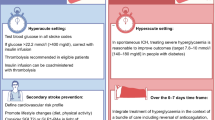Abstract
Low-molecular-weight heparin (LMWH) has largely replaced unfractionated heparin for the treatment of venous thromboembolism. The predictable anticoagulant effect of LMWH is seen across almost all patient populations, with few exceptions. However, because LMWH is primarily eliminated through the kidneys, patients with renal insufficiency are at risk of LMWH accumulation and bleeding complications. The risk of LMWH accumulation and bleeding is dependent on several factors including the degree of renal insufficiency, dose and type of LMWH. These risks are greatest when therapeutic doses of LMWH are used in patients with creatinine clearance less than 30 ml/min. Prophylactic dose LMWH does not appear to be associated with an increased bleeding risk, but has not been evaluated in large trials. LMWHs with a higher molecular weight may be less prone to accumulation and bleeding. LMWH must be used carefully in patients with renal insufficiency, particularly in those with severe renal impairment.
Similar content being viewed by others
References
van Dongen CJ, van den Belt AG, Prins MH et al (2004) Fixed dose subcutaneous low molecular weight heparins versus adjusted dose unfractionated heparin for venous thromboembolism. Cochrane Database Syst Rev 4:CD001100
Simonneau G, Sors H, Charbonnier B et al (1997) A comparison of low-molecular-weight heparin with unfractionated heparin for acute pulmonary embolism. N Engl J Med 337:663–669
Quinlan DJ, McQuillan A, Eikenboom JW (2004) Low-molecular-weight heparin compared with intravenous unfractionated heparin for treatment of pulmonary embolism. Ann Intern Med 140:175–183
Hirsh J, Raschke R (2004) Heparin and low-molecular-weight-heparin: the seventh ACCP conference on antithrombotic and thrombolytic therapy. Chest 126:188S–203S
Koopman MM, Prandoni P, Piovella F et al (1996) Treatment of venous thrombosis with intravenous unfractionated heparin administered in the hospital as compared with subcutaneous low-molecular-weight heparin administered at home. N Engl J Med 334:682–687
Schraibman IG, Milne AA, Royle EM (2001) Home versus in-patient treatment for deep vein thrombosis. Nurs.Times 97:35
Kidney Disease Outcome Quality Initiative (2002) K/DOQI clinical practice guidelines for chronic renal disease: evaluation, classification, and stratification. Am J Kidney Dis 39:S1–S46
Douketis J, Cook D, Meade M et al (2008) Prophylaxis against deep vein thrombosis in critically ill patients with severe renal insufficiency with the low-molecular-weight heparin dalteparin: an assessment of safety and pharmacodynamics. The DIRECT (Dalteparin’s Influence on REnally Compromised anti-Ten-A) study. Arch Intern Med (in press)
Landefeld CS, Beyth RJ (1993) Anticoagulant-related bleeding: clinical epidemiology, prediction, and prevention. Am J Med 95:315–328
Mahe I, Aghassarian M, Drouet L et al (2007) Tinzaparin and enoxaparin given at prophylactic dose for eight days in medical elderly patients with impaired renal function: a comparative pharmacokinetic study. Thromb Haemost 97:581–586
Mahe I, Gouin-Thibault I, Drouet L et al (2007) Elderly medical patients treated with prophylactic dosages of enoxaparin: influence of renal function on anti-Xa activity level. Drugs Aging 24:63–71
Tincani E, Mannucci C, Casolari B et al (2006) Safety of dalteparin for the prophylaxis of venous thromboembolism in elderly medical patients with renal insufficiency: a pilot study. Haematologica 91:976–979
Lim W, Dentali F, Eikelboom JW et al (2006) Meta-analysis: low-molecular-weight heparin and bleeding in patients with severe renal insufficiency. Ann Intern Med 144:673–684
Falga C, Capdevila JA, Soler S et al (2007) Clinical outcome of patients with venous thromboembolism and renal insufficiency. Findings from the RIETE registry. Thromb Haemost 98:771–776
Santopinto JJ, Fox KA, Goldberg RJ et al (2003) Creatinine clearance and adverse hospital outcomes in patients with acute coronary syndromes: findings from the global registry of acute coronary events (GRACE). Heart 89:1003–1008
Collet JP, Montalescot G, Agnelli G et al (2005) Non-ST-segment elevation acute coronary syndrome in patients with renal dysfunction: benefit of low-molecular-weight heparin alone or with glycoprotein IIb/IIIa inhibitors on outcomes. The Global Registry of Acute Coronary Events. Eur Heart J 26:2285–2293
Siguret V, Pautas E, Fevrier M et al (2000) Elderly patients treated with tinzaparin (Innohep) administered once daily (175 anti-Xa IU/kg): anti-Xa and anti-IIa activities over 10 days. Thromb Haemost 84:800–804
Pautas E, Gouin I, Bellot O et al (2002) Safety profile of tinzaparin administered once daily at a standard curative dose in two hundred very elderly patients. Drug Safety 25:725–733
Cook LM, Kahn SR, Goodwin J et al (2007) Frequency of renal impairment, advanced age, obesity and cancer in venous thromboembolism patients in clinical practice. J Thromb Haemost 5:937–941
Alexander KP, Chen AY, Roe MT et al (2005) Excess dosing of antiplatelet and antithrombin agents in the treatment of non-ST-segment elevation acute coronary syndromes. JAMA 294:3108–3116
LaPointe NM, Chen AY, Alexander KP et al (2007) Enoxaparin dosing and associated risk of in-hospital bleeding and death in patients with non ST-segment elevation acute coronary syndromes. Arch Intern Med 167:1539–1544
Aventis Pharma Inc (2004) Lovenox product monograph (enoxaparin sodium)
Fox KA, Antman EM, Montalescot G et al (2007) The impact of renal dysfunction on outcomes in the ExTRACT-TIMI 25 trial. J Am Coll Cardiol 49:2249–2255
Lachish T, Rudensky B, Slotki I et al (2007) Enoxaparin dosage adjustment in patients with severe renal failure: antifactor xa concentrations and safety. Pharmacotherapy 27:1347–1352
Acknowledgments
W. Lim is the recipient of a Canadian Institutes for Health Research Randomized Controlled Trials Mentoring Award.
Conflict of interest statement
The author has received an unrestricted educational grant from Leo Pharma, is on the Speaker’s bureau for Leo Pharma and Pfizer, has received honoraria for these presentations from Leo Pharma and Pfizer, and has participated on a scientific advisory board for Pfizer.
Author information
Authors and Affiliations
Corresponding author
Rights and permissions
About this article
Cite this article
Lim, W. Low-molecular-weight heparin in patients with chronic renal insufficiency. Intern Emerg Med 3, 319–323 (2008). https://doi.org/10.1007/s11739-008-0164-9
Received:
Accepted:
Published:
Issue Date:
DOI: https://doi.org/10.1007/s11739-008-0164-9




